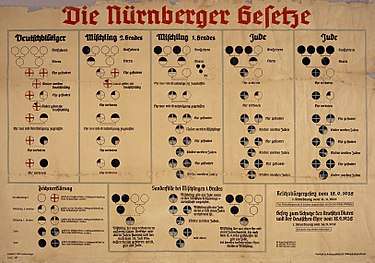Anti-Jewish laws
Anti-Jewish laws have been a common occurrence throughout Jewish history. Examples of such laws include special Jewish quotas, Jewish taxes and Jewish "disabilities".
Some were adopted in the 1930s and 1940s in Nazi Germany and Fascist Italy and exported to the European Axis powers and puppet states. Such legislation generally defined Jews, deprived them of a variety of civil, political, and economic rights, and laid the groundwork for expropriation, deportation, and ultimately the Holocaust.
Nazi Germany

The 1933 Law for the Restoration of the Professional Civil Service excluded all "non-Aryans", including those who had even just one Jewish grandparent (in contrast to the way the Nuremberg Laws of 1935 regarded such people, as "quarter-Jews ("Vierteljuden")) from the civil service. In 1935, the Nazis passed the Nuremberg Laws which forbid Jews from citizenship and prohibited sexual relations and marriages between Jews and "Aryans". The total number of laws against Jews reached 400 since the end of the war. The issuing of laws begun in 1933, with 80 until the Nuremberg Laws, and the other decrees were issued against the Jews after the Nuremberg Laws.
Fascist Italy
The Manifesto of Race published on July 14, 1938, prepared for the enactment of racial laws to be introduced. The Italian Racial Laws were passed on November 18, 1938, excluding Jews from the civil service, the armed forces, and the National Fascist Party, and restricting Jewish ownership of certain companies and property; intermarriage was also prohibited.[1] The legislation remained in effect after the fall of Mussolini for the first months of the Badoglio government,[2] before being repealed on January 20, 1944.[3]
Slovakia
Slovakia passed its first racial legislation on April 18, 1939, defining Jews as including religious Jews, and any Jews baptized after October 30, 1918.[4] According to Morley, "the Jewish Code was promulgated on September 9, 1941, without the approval of the Slovak parliament or the signature of Tiso".[5] The Slovak parliament on May 15, 1942 retroactively legalized the deportations, deprivation of Jewish citizenship, and expropriation of property that had occurred.[6]
Romania
In August 1940, the Romanian government passed legislation that Jews who converted to Christianity would be regarded as Jews for legal purposes, and barred from marriage with ethnic Christians; by defining Jews not based on religion this was "the first step, and a large one at that, to further racial legislation".[7]
France
France passed its Statute on Jews in October 1940. Similar legislation was adopted later that year in the French possessions of Algeria, Morocco, and Tunisia.
Bulgaria
Bulgaria passed its anti-Jewish code, the Law for protection of the nation, in 1941.
Croatia
The Independent State of Croatia issued a definition of Jews on April 30, 1941, laying the groundwork for expropriation and forced labor, followed by deportations.[8]
Notes
References
- Morley, John. 1980. Vatican diplomacy and the Jews during the Holocaust, 1939-1943. New York: KTAV Pub. House. ISBN 0-87068-701-8.